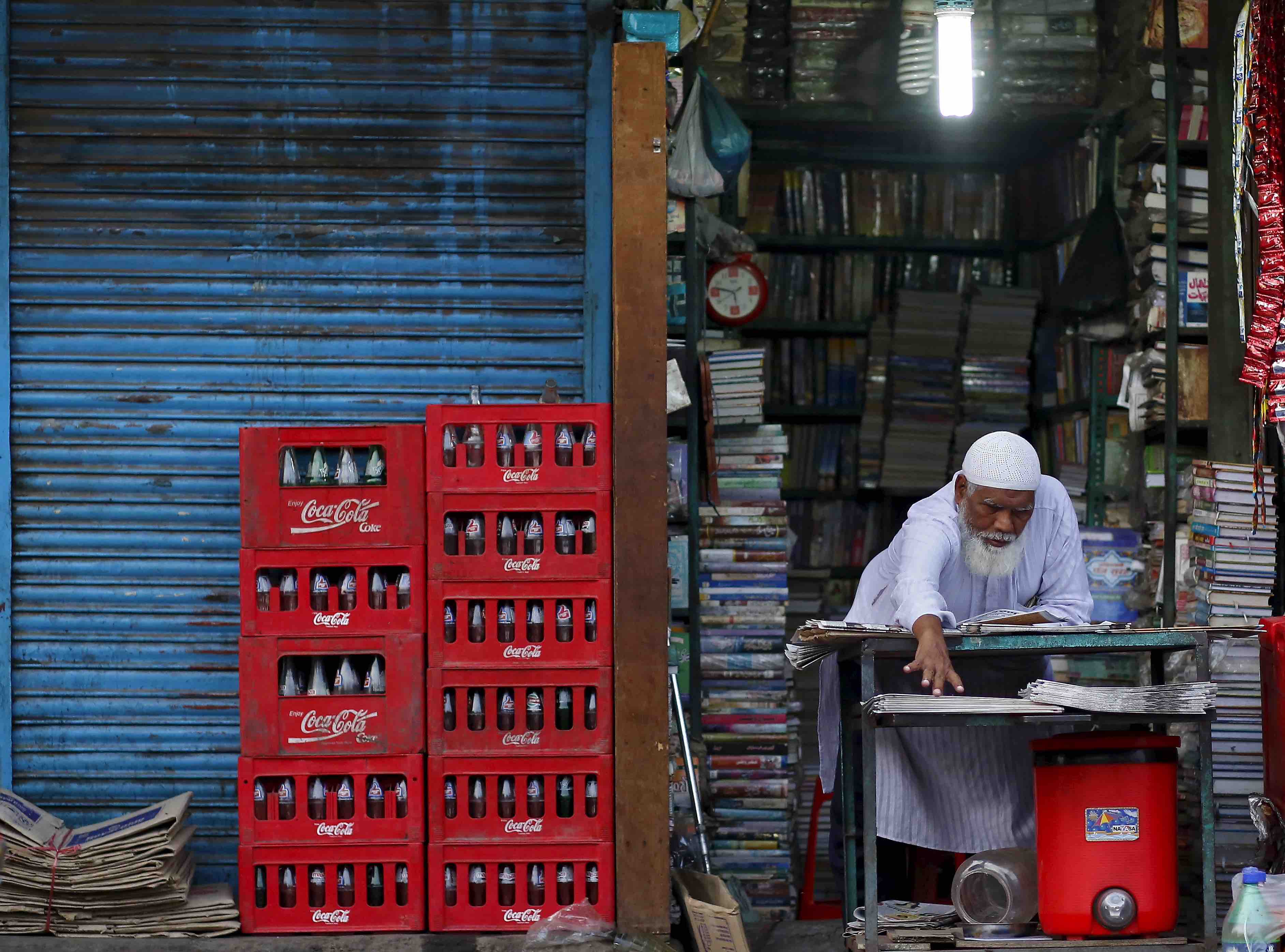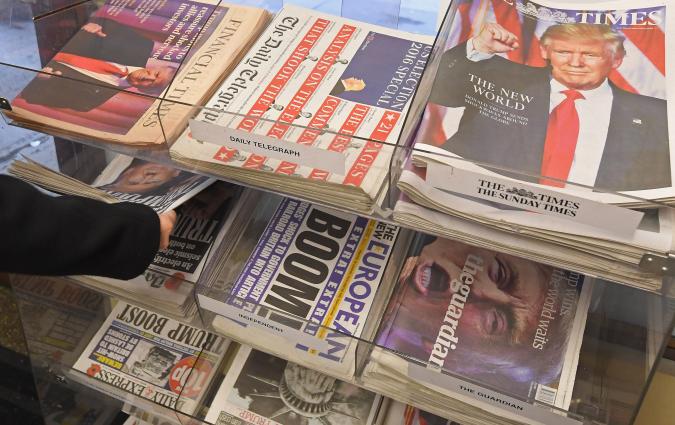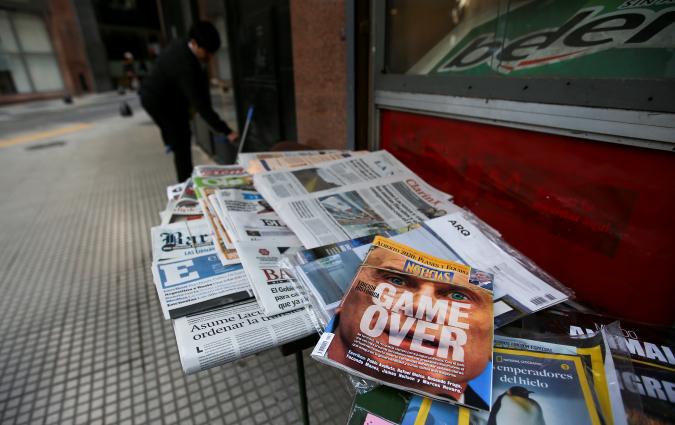In this piece
Making the cut: how newsrooms fare when they publish less

A shopkeeper arranges newspapers for sale at his shop in Delhi, India. REUTERS/Anindito Mukherjee
In this piece
Slovak pop artist Miroslav ‘Meky’ Žbirka’s death on 10 November 2021 should have launched a torrent of news reports in his native Slovakia – and it did. Just not at Denník N, which put out only a brief alert:
“Miroslav Žbirka has died, aged 69. ‘The news of my death is true,’ Meky would say if he were alive, the singer’s Facebook page announced. It was confirmed by his PR manager, Rado Mešša.”
They could have put together a wordy report – as news publishers are wont to do on such occasions – and perhaps even a feature about the witty Facebook post. But Denník N operates by a distinct philosophy: publish what is most relevant or original, no more.
Meky’s passing was, in that moment, the most relevant piece of information – so that’s all Denník N published. They felt no obligation to wrap it in a story of a few hundred words. Reports and features exploring the life and works of the iconic singer would follow in due course: a bouquet of original journalism rather than the chaff of rehashed content.
Originality, in subject or its treatment, is a core precept at Denník N. “[That] has been our strategy from the beginning,” Lukas Fila, director of Denník’s publisher, N Press, told Nieman Lab. “People are not willing to pay for things they can read elsewhere.”
This philosophy, baked into the Slovakian news platform’s conceptual design, has earned it success in an industry grappling with the loss of readers, revenue and trust. Denník N, only 7 years old, boasts 1.55 million visitors a month and 67,000 subscribers. It made US$6.4 million in total revenue in 2021 – over 60% from subscriptions – and $1.4m in operating profit.
Denník N’s approach to journalism is what French journalist Sophie Casals summarises as “publish less, but publish better”. It’s an approach that represents a break with the flailing but still dominant news industry practice of generating content on an industrial scale. It’s a counterpoint to a pressing problem: the “contentification” of journalism.
Consider India, where I live. In that country of over 1.38 billion people – and as many stories – the bulk of what’s published online in the name of news has little value. Because newsroom resources are dedicated primarily to generating content most likely to grab eyeballs, there is hardly scope for public service journalism. Even valuable journalistic work, when done, often lacks in depth, rigour or quality of production. And because the mostly underpaid, overworked journalists are required to create content as if on an assembly line, and cheaply, they go after the easy pickings – celebrity gossip, political slugfests, social media chatter, and, increasingly, religious hatred. An army of “content makers” running full tilt on the “churnalism treadmill”. Befittingly, several top news outlets have redesignated their journalists as “content producers”.
Not surprising then that interest in news is declining across countries, as the Reuters Institute’s 2021 Digital News Report notes, “despite the turbulent times in which we live”. One reason, a Nieman Lab survey indicates, is that readers don’t find content produced by media platforms valuable or are simply overwhelmed by its abundance.
Nearly 13% of the survey’s respondents “thought a publication had become too clickbaity or non-substantive, or found that the content generally wasn’t useful to them or just wasn’t worth paying for”. An equal percentage cancelled their subscriptions “because of information overload”. Some complained that the content wasn’t original. Why would they pay for content they could get for free elsewhere? The contentification of journalism, thus, not only undermines trust, it’s also a risky business gambit.
It’s injurious to democracy too, for trust in the media and democracy go hand-in-hand. If the media isn’t considered trustworthy enough to keep voters informed, its worth as a key pillar of democracy is diminished. Indeed, a public institution without trust in a democratic society arguably has no legitimate reason to exist.
The nexus of contentification and the loss of trust, readers, and revenues also enables a more malicious phenomenon. Again, take India. The ruling Hindu supremacists and their allies in the media – taking a cue from American rightwing ideologue Steve Bannon’s playbook – constantly flood the news with so much distraction and hatred it’s hard to tell news from propaganda anymore. To be effective, propaganda and distraction must be relentless. Co-opted media, therefore, must generate ever more content to shrinkwrap lies, xenophobia and ressentiment in.
One outcome, by default if not design, is the dystopia of Aldous Huxley’s Brave New World, where the public is controlled not by being deprived of useful information, as George Orwell feared, but by being drowned in trivialities. Huxley lamented that the early advocates of free press who envisaged propaganda as a true or false binary did not factor in the growth of “a vast mass communications industry, concerned in the main neither with the true nor the false, but with the unreal, the more or less totally irrelevant”. Huxley saw irrelevant words, “words without reason”, as potentially more harmful than false words.
Yet, “words without reason” could double as a descriptor for much of the content created by digital news publishing.
The “publish less but publish better” credo is a solution to problems outlined above, and more – audience fatigue, staff fatigue, quality assurance, resource allocation to name a few. To paraphrase Bannon, this approach will ensure that the media isn’t “flooded with shit”.
Mediapart has shown that it can be a winning strategy. The French news outlet, which went live in 2008, is a pioneer of the ‘publish less but better’ model. The decision of its founders to rely from the outset on readers and not advertisers for revenue freed them from the obligation of producing content for clicks. They devoted their resources instead to doing original and investigative journalism – and to audience engagement – and quickly found success, disproving conventional wisdom. They knew they would only be “a little fish” in the news industry, Edwy Penel, Mediapart’s co-founder and guiding force, told me, but they would be “a clean, proud fish in a putrid sea”.
Mediapart now boasts over 221,000 subscribers. It’s staffed by 131 people, nearly half of them editorial staff who publish 12-15 articles per day, in three editions. It earned 21.3 million in revenue in 2021 and a net profit of about 4 million, 18% more than the previous year.
Mediapart’s model, or elements of it, have since been adopted by publishers around the world, with varying degrees of success. Denník N, the Guardian in the United Kingdom, the Ken in India, Tiempo Argentino in Argentina, El Diario in Spain, and Quartz in the United States, each guided by their particular journalistic vision as much as by financial compulsion, have all either stepped off the churnalism treadmill, are trying to, or never jumped on in the first place.
During my time at the Reuters Institute, I interviewed editors and researched content limiting strategies at Mediapart, Denník N, Tiempo Argentino, El Diario, the Ken, Quartz, and the Guardian to understand why and how they cut back on content, and what the limitations of this strategy may be.
In summary, the publishers I spoke to have found that publishing less but better enables them to invest in better content rather than more content which entices readers to pay, which reduces reliance on advertisers, which enhances perception of independence, which boots credibility, which earns trust, which smoothes engagement with reader and establishes a channel of feedback that serves both parties.
In short, content de-addiction yields a model combining the essential elements of fine journalism – quality, independence and trust – with financial sustainability.
It doesn’t lose readers either.
This approach has pitfalls, of course. It could lead to news publishers “super-serving richer and more educated audiences and leaving others behind”, dissuade exploration of revenue streams other than subscriptions lest that erode the perception of independence, deepen ideological rifts, and feed a situation where the “truth is paywalled and the lies free”. It could, in sum, trap publishers and their loyal audiences in potentially self-destructive bubbles.
Such risks can be significantly mitigated, however, by creating a more diverse, democratic newsroom, making data-informed decisions, and ensuring greater transparency in editorial and business decisionmaking.
As the first step, though, publishers need to see content not as a product, but capital. Which will yield rich returns, for publishers and democracy, only if it is judiciously invested.
Every single piece of it.




